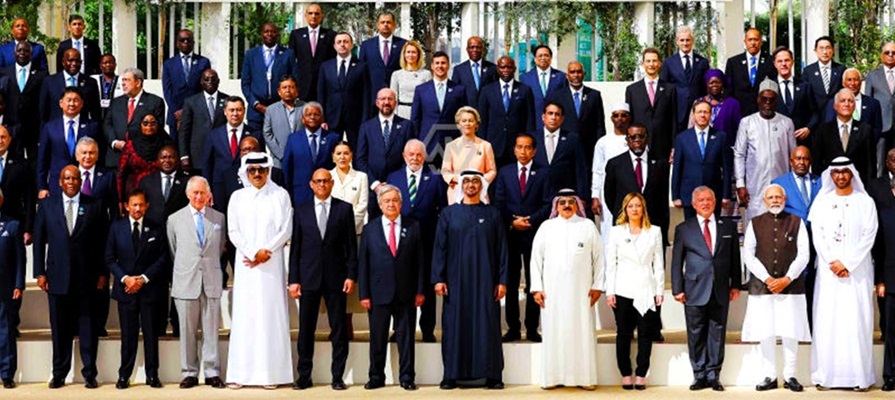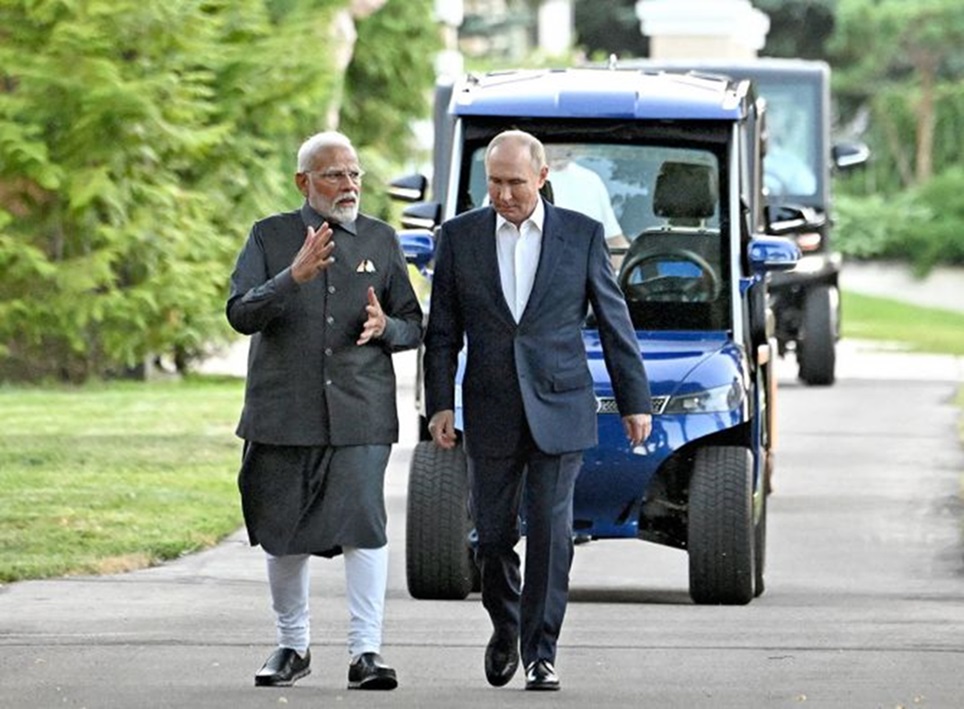Unprecedented spells of hot weather are expected to occur far more frequently over large areas of India in the coming years due to global warming. Regardless, India refrained from signing the COP28 declaration on climate and health at the recently concluded meeting in UAE.
Under a blistering sun barely softened by the rare monsoons, Indian Prime Minister Narendra Modi greets the world leaders who have come to negotiate the climate future of humanity with a broad smile. It is November 2023 and New Delhi is about to kick off the 28th United Nations Climate Change Conference.
What a contrast between the virtuous image that India, an inherently spiritual land, wants to project to the world by hosting this global summit, and the much more mixed reality of its domestic climate policy. Granted, as a leader of the Non-Aligned Movement, this country has always strongly defended the Global South’s cause in the face of environmental disruptions for which they are the primary victims without being responsible. But behind this legitimate fight for climate justice also lies the double talk of a country torn between its international ambitions and development urgencies.
The observation is clear: India is already one of the countries where the impacts of global warming are being felt most violently. Extreme heat waves, mega-storms, and prolonged droughts now punctuate the daily lives of hundreds of millions of Indians. The monsoon, the country’s agricultural breadbasket, becomes more capricious every year under the influence of overheating oceans, directly threatening the food security of the demographic giant. And yet, at the same time, the country continues to increase its dependence on imported coal to sustain economic growth which has become a national obsession.
So is the land of Gandhi sincere in its desire to take up the torch of the fight against global warming by running for host of the planetary climate jamboree? Or is this above all a clever communication maneuver aimed at restoring the image of a country still seen as a significant global polluter? India has reached a turning point. And its international climate credibility will largely depend on its ability to speak the truth about its shortcomings, rather than cloak itself as a smug do-gooder.
This is the very issue at stake in this article, which aims to objectively scrutinize the real motivations behind New Delhi’s COP28 hosting bid. While not denying India’s essential role as a spokesperson for developing nations in climate arcana, the focus will be on factually examining the extent to which this fragile and turbulent country is truly capable of carrying on its frail shoulders the weight of international negotiations on the planet’s future. Will Modi’s India seize the historic opportunity that seems to be presenting itself? Or does India risk burning its wings by getting too close to the sun of a global diplomatic stage that forgives no missteps?
India at the Climate Crossroads: The Challenges of Hosting a COP in New Delhi
As international pressure intensifies to accelerate the concrete implementation of the climate objectives set out in the Paris Agreement, India finds itself at a crossroads more than ever. Long seen as an eternal drag on global climate progress due to the ardent defence of its right to development, this demographic behemoth seems to be significantly changing its stance.
This is evidenced by Prime Minister Narendra Modi’s surprise announcement at COP26 in Glasgow of a carbon neutrality target for his country…by 2070. Certainly far from the 2050 horizon advocated by UN experts, but still the first significant overture for a country that currently heavily relies on fossil fuels. Proof of this apparent virtuous shift, India now sees itself well suited to take on the prestigious role of next host country of the planetary climate jamboree at a hypothetical COP33 in New Delhi.
If confirmed, such a perspective would place the South Asian nation under significant pressure given the immense expectations from the International Community towards the world’s third-largest CO2 emitter. Because between the temptations of immediate diplomatic dividends from such an event and the need to make concrete progress in its low-carbon transition beforehand, Gandhi’s country seems caught between two fires.
On one hand, the geostrategic motivations are evident for the Indian elites: confirming New Delhi’s restored status as an emerging global power, attracting the massive investments that India urgently requires for green infrastructure, setting an example in terms of climate change adaptation solutions developed in South Asia, etc. So many arguments pushing Modi & his nationalist government to fiercely compete for hosting 2023’s planetary get-together. Especially if welcoming such a summit allows India to restore its image and establish itself as a heavyweight diplomatic broker between the Global North & South.
But on the other hand, the stark reality of the domestic Indian climate landscape remains highly concerning. Between a population suffering increasingly deadly heat waves, tropical agriculture at the mercy of ever more chaotic monsoons, and megacities choked by endemic air pollution, the observation is clear: climate disruption is already hitting the Indian subcontinent hard. Just during the dramatic 2022 monsoon season alone, no less than 1,500 Indians lost their lives in cataclysmic floods. Proof, if any was needed, of the dire necessity to accelerate climate action in the planet’s second most populous country, even before envisioning making it the showcase of international negotiations.
Such is the paradox confronting India in 2023. Symbolically, it is burning to play with the big boys by wearing the hat of the climate champion. But in reality, the country still has a long way to go in drastically cutting its coal dependency, the cornerstone on which 70% of its current power mix still rests.
So does New Delhi’s COP33 hosting bid reflect legitimate ambition or misplaced hubris? Does India have robust enough foundations to credibly take on the role of host for international negotiations? Or would it be better off spending all its energy seriously aligning its domestic climate actions with the virtuous leadership it trumpets on the world stage? Three long years still separate it from the fateful deadline when its COP28 bid could become reality. That’s a minimal respite to reverse the still entrenched dynamic of fossil fuels dependency and finally set its emerging economy on a truly sustainable trajectory. Time has never been more pressing for the Indian climate. At the dawn of 2023, India seems to have become fully aware of the emergency. The only question is whether political will this time will be equal to the action.
A Country Already Hard Hit by Climate Disruption
While climate change is a global phenomenon that spares no nation, India is without question among those where it is already raging most violently. The numbers speak for themselves: over the last 20 years, the country’s average temperature has increased by 0.7°C – a warming rate twice as fast as the rest of the planet.
At the scale of this territory as vast as 2.5 times Europe, inhabited by 1.4 billion people and crossed by some of the largest rivers on Earth, the concrete consequences of this heat rise were quick to emerge. Indian scientists warn of a 6-fold multiplication of extreme heat wave episodes over recent decades. Just during the summer of 2022 alone, the country endured three major heat waves, causing the premature death of over 7,000 people in a land where air conditioning remains a rare luxury.
But beyond this appalling human toll, it is the stability of the entire Indian natural system that seems to falter under the heat blow of climate disruptions. The Ganges, this sacred river that nurtures 400 million Indians throughout its basin, has seen its flow collapse by 20% during drought periods. The Himalayan glaciers, the true Asian water towers, are dangerously receding – threatening the water reserves of the country’s big Northern cities in the long run. As for the monsoon, this capital rainy season for Indian tropical agriculture, it grows more erratic every year under the influence of abnormally warm oceans. A real sledgehammer blow to the food security of a country where 70% of the population still lives from traditional rain-fed agriculture.
This growing destabilization of the Indian climate also dramatically intensifies extreme weather events across the subcontinent. Be it Kerala devastated by the worst floods in its history (500 dead in 2018), Chennai submerged by record-breaking torrential downpours (27cm of rain in 24h in 2015), Bengal pounded by Cyclone Amphan, one of the most powerful ever observed in the Bay of Bengal (128 dead in 2020) or the Uttarakhand mountains transformed a bit more every year into Himalayan cemeteries (over 5,000 pilgrims killed in flash floods in 2021)…today no region of the country is spared anymore from the brutal onslaught of climatic elements.
All in all, Indian authorities estimate that meteorological disasters have claimed the lives of nearly 150,000 of their fellow citizens over just the last decade alone. Dire human costs that make India one of the most battered lands on Earth by climate change. A sad record that the South Asian demographic giant could have done without and whose future climate impact projections bode nothing good if the trajectory of global emissions fails to radically bend downwards. And this, despite all local efforts undertaken so far to adapt to the adverse effects of an increasingly inhospitable climate…
A Climate Leadership to Confirm
As the global climate system inexorably spirals into disruption with potentially catastrophic consequences, the International Community strives year after year to keep climate negotiations on track to try and save what can still be saved. And in this concert of desperate nations in search of solutions, India seems to want to gradually play first fiddle.
Long perceived as an eternal drag on global climate progress, stuck to sovereigntist positions fiercely defending above all its right to development, Narendra Modi’s India has been undergoing an understated yet notable diplomatic shift over recent years. Without ever officially renouncing its domestic tensions between national economic ambitions and global environmental pressures, Indian discourse is significantly evolving. Gone are the stubborn refusals of any external carbon constraints – giving way to a commitment that, albeit conditional, nonetheless signals an endorsement of the international climate cause.
The proof is Prime Minister Modi’s surprise announcement at COP26 in Glasgow of a carbon neutrality target for his country by 2070. Twenty years behind rival regional powerhouse China, with whom India now seems eager to compete for Asian climate leadership. Undoubtedly a far cry from the 2050 horizon called for by UN experts, but still a non-negligible first concession from a country that still relies on coal for 70% of its entire electricity output. Another strong signal sent to the international community: India’s promise to generate 50% of all its power from solar, wind or hydro by 2030 – compared to just 20% for Europeans today…
Ambitious bets on the future or mere declarations of intent aimed at appeasing Western partners? Only time will tell. But it is clear that both in substance and discourse, India is now seeking to establish itself as a climate leader in the emerging world. And what better way to confirm its rediscovered green ambitions than to vie for hosting the planetary diplomatic jamboree that is the COP?
Because after all, the prospect of Delhi hosting COP33 in 2023 comes at just the right time to enable Gandhi’s country to realize its international aspirations. The perfect occasion for this demographic giant to restore its blazon, to regain respectability in the eyes of the West by dazzlingly demonstrating its newfound climate leadership. And above all to showcase its solutions in the face of the ecological emergency, in the hope that it set an example for other major emerging countries. Whether resilient farming techniques, early warning systems for cyclones or groundwater recharge programs, Indians certainly have no lack of expertise to promote in terms of adaptation.
Yet as often with India, the reality on the ground differs significantly from the posture outwardly displayed. Because behind the virtuous image, it now aims to project internationally the harsh reality of a country plagued by domestic contradictions. Admittedly the momentum seems underway towards greening its so long-delayed carbon-intensive economic growth model. But the path ahead remains strewn with obstacles for power still 70% coal-powered and planning to increase its national emissions by +50% by 2040…So is COP33 the ideal springboard to seal India’s long-awaited advent as a global climate leader? Or a premature step for an emerging heavyweight still stuck in its internal climate tensions? The coming years’ challenge will be to deliver, to translate these fine climate words too rarely followed by action into concrete bold steps. And it is only at that price that the country will perhaps then have truly earned its stripes to don the prestigious garb of host of the international climate negotiations.
Expected Economic and Diplomatic Gains
Beyond the hoped-for reconfirmation of its restored status as an unavoidable emerging power on the international stage, India also intends to reap some substantial economic and diplomatic dividends from hosting the grand planetary climate shindig that is COP33.
Business interests first. Despite its traditional image as a land of spirituality detached from worldly concerns, India fully intends to transform the hosting of the UN jamboree on its soil into a real national financial windfall. In tourist revenue alone, the coming of 25,000 foreign delegates and observers can deliver hefty returns for a local economy eager for hard currency. Between hotel nights, transportation, catering and crafts, the expected benefits are projected in hundreds of millions of euros.
But beyond this one-off jackpot, it is also an ideal opportunity for the Indian private sector to capture a share of international climate funds that will be at the heart of COP33 discussions. By elevating its profile as an unmissable green destination, India hopes to attract the massive financing it direly needs to build the low-carbon infrastructure of its economy of tomorrow. Renewable energy, clean transport, regenerative agriculture…so many crucial areas where local industrial groups are betting on the showcase of a New Delhi-based COP to secure foreign technology transfers and pioneering commercial partnerships. Even if it means the Modi government has to dip into the public purse beforehand if this is what it takes to deliver the long-awaited decisive impulse towards the country’s energy transition.
Last but not least, India’s unacknowledged motive behind its COP33 bid remains its hopes for indirect geopolitical gains. By taking over from the controversial COP27 in Cairo, India is counting on the automatic windfall effect for its image simply from becoming the host territory for negotiations crucial to the planet’s future. A sort of proxy membership to the virtuous club of global ecology “good guys”, which would conveniently counter it’s lingering bad reputation as a climate laggard. Above all, New Delhi’s diplomatic elites are betting on this unexpected spotlight to establish themselves as a heavyweight intermediary between the opposing North-South climate demands…a highly strategic role in an increasingly fractured world divided between rich and poor nations.
Such is the covert motivations pushing Modi & his government to covet so insistently the hosting of the planetary mega-event.
Domestic Risks Not to be Overlooked
Because behind the shiny storefront India wants the world to see through a New Delhi-based COP lurk multiple risks and challenges for the host country. The first pitfall for Indian authorities to anticipate: is the logistical burden of such a planetary event in an already overcrowded and polluted megalopolis like New Delhi. On security aspects alone, protecting 30,000 expected participants represents an unprecedented conundrum for Indian law enforcement seldom confronted with such a challenge before. Between counter-terrorism special forces, armed guards and undercover police, this will require the exceptional mobilization of security resources to be financed by the local taxpayer. The budget allocated to the event’s safety reaches about €115 million already… enough to make more than one Indian parliamentarian cringe, in a country where social issues remain explosive.
But the main lurking danger behind a homegrown COP remains the immense reputation risk for India as a host if by misfortune its domestic climate action continues to stray further from the straight and narrow by 2023. There is no doubt international NGOs and other green activists will jump on the dream occasion to spotlight India’s climate ambivalence, loudly decrying the doublespeak between its lofty international declarations and concrete implementation failures at home. Between a population under deadly heat waves, agriculture at the mercy of chaotic monsoons and megalopolises choked by smog, they will have no shortage of angles for frontal attacks.
To the point the New Delhi COP could backfire into a giant media trial against India itself as organizers, should the country fail to seriously align its deeds with its impassioned ecological speeches. How to establish one’s credibility as the host of a planetary climate summit while remaining 70% dependent on coal energy increasingly shunned as beyond the pale? Hard under such conditions to set oneself up as a paragon of green virtue… Hence the imperative for India to swiftly shift its domestic trajectory towards the concrete rails of a rapid low-carbon transition, under penalty of burning its nascent climate credit on the COP28 altar.
In short, the real risk for this continental-sized country lies less in the operational feasibility of hosting such a mammoth global event on its soil than in the resulting worldwide media exposure. And how brutally this could backlash if realities on the Indian ground violently belie New Delhi’s carefully crafted green communication spin. A very real sword of Damocles reputationally speaking, further encouraging the Indian giant to promptly undergo an ecological metamorphosis of its development model nationally.
Conclusion
At the end of this overview, one fact becomes clear: India seems to have fully realized it now stands at a historic turning point in its attitude towards the planetary climate challenge. Long torn between its legitimate development aspirations as a Southern country and the growing pressures to step up its environmental efforts, here it sets sail with determination on the exacting path of ecological transition.
Admittedly, many hurdles still dot the road before converting this demographic giant towards genuinely sustainable, low-carbon growth. The ingrained coal reflexes persist tenaciously and both elites and public opinion will take time to integrate all implications of this necessary passage towards a new carbon-sober prosperity paradigm. But for the first time, India appears to have fully grasped the stakes, and the virtuous momentum only awaits triggering.
Therefore, vying for COP33 hosting in 2023 would represent less an end in itself prestigious for the country than a decisive milestone helping India consolidate its gradual shift towards confident climate leadership. A tremendous accelerator making it possible to measure progress already covered in three years, but also reveal the immense possibilities still laying ahead for it in terms of green innovations serving the greater good.
Of course, welcoming the planetary media circus of the COP on one’s soil also carries significant risks for scathing criticism, should action fall behind fiery discourse. But that is precisely what should spur Gandhi’s land to redouble ambition to silence sceptics bound to emerge. Under healthy peer pressure, no doubt India will then find resources to achieve in just a few years the energy revolution it has sorely lacked in past decades. And finally, confirm its restored status as a responsible climate power; even if the 2070 carbon neutrality timeline seems still distant given the dire emergency…
So yes, throwing India’s hat in the ring to host the 2023 climate mega-event would be an audacious yet rewarding gamble for this great
Disclaimer: The views and opinions expressed by the author do not necessarily reflect the views of the Government of India and Defence Research and Studies
Title image courtesy: Medium






